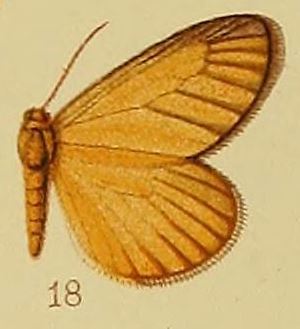Carpostalagma is a genus of moths in the subfamily Arctiinae. The genus was described by Ferdinand Karsch in 1894.

Deudorix is a large genus of butterflies in the family Lycaenidae. The species of this genus are found in the Old World and Australia.

Secusio is a genus of moths in the subfamily Arctiinae first described by Francis Walker in 1854.

Crorema is a genus of moths in the subfamily Lymantriinae. The genus was erected by Francis Walker in 1855.

Thermochrous is a genus of moths in the Anomoeotidae family.
Deudorix chalybeata is a butterfly in the family Lycaenidae. It is found on São Tomé Island.
Apisa subargentea is a moth of the family Erebidae. It was described by James John Joicey and George Talbot in 1921. It is found in Burundi, the Democratic Republic of the Congo, Kenya and Rwanda.
Carcinarctia kivuensis is a moth of the family Erebidae. It was described by James John Joicey and George Talbot in 1924. It is found in the Democratic Republic of the Congo, Tanzania and Zaire.
Carcinarctia rufa is a moth of the family Erebidae. It was described by James John Joicey and George Talbot in 1921. It is found in the Democratic Republic of the Congo, Rwanda and Uganda.
Carpostalagma pulverulentus is a moth of the subfamily Arctiinae. It was described by George Talbot in 1929. It is found in Kenya and Uganda.
Carpostalagma signata is a moth of the subfamily Arctiinae. It was described by George Talbot in 1932. It is found in Zambia.
Disparctia thomensis is a moth species of the family Erebidae. It was described by James John Joicey and George Talbot in 1926. It is found on São Tomé Island off the western equatorial coast of Central Africa.
Macrosia chalybeata is a moth of the subfamily Arctiinae. It was described by George Hampson in 1901. It is found in Kenya, Lesotho, Malawi, South Africa and Zimbabwe.
Podomachla insularis is a moth of the family Erebidae first described by George Talbot in 1929. It is found on São Tomé Island.
Secusio discoidalis is a moth in the subfamily Arctiinae. It was described by George Talbot in 1929. It is found in Angola, the Democratic Republic of the Congo, Somalia and South Africa. The species host plants have yet to be discovered.
Afrocerura cameroona is a moth in the family Notodontidae first described by George Thomas Bethune-Baker in 1927. It is found in Cameroon, the Democratic Republic of the Congo, Gabon and São Tomé & Principe.
Meganola hypenoides is a species of moth of the family Nolidae. It occurs on São Tomé Island, an island off the western equatorial coast of Central Africa. The species was described by George Talbot in 1929 as Nola hypenoides based on specimens collected in 1925 by T.A. Barns. In 2012, it was placed in the genus Meganola.


